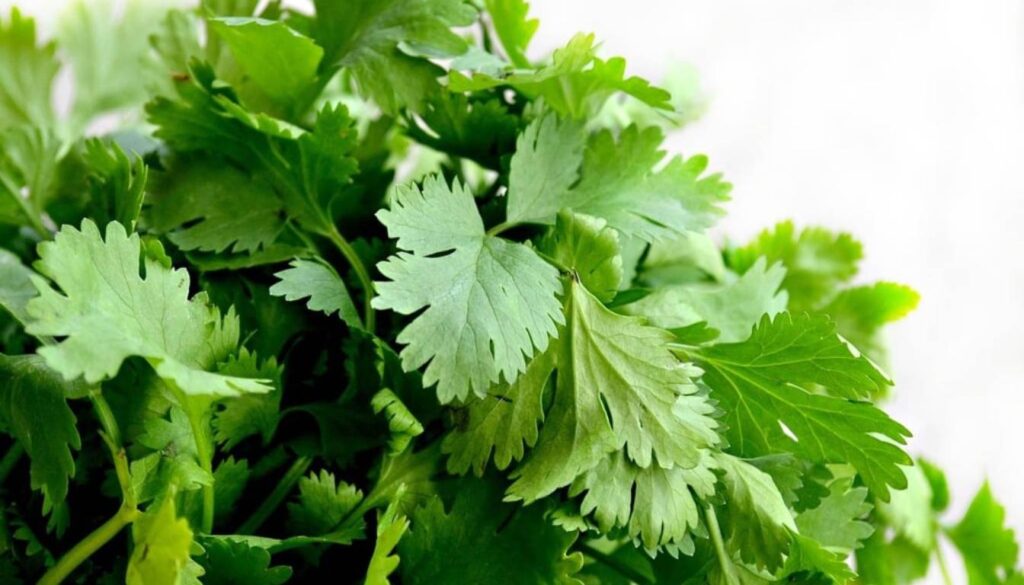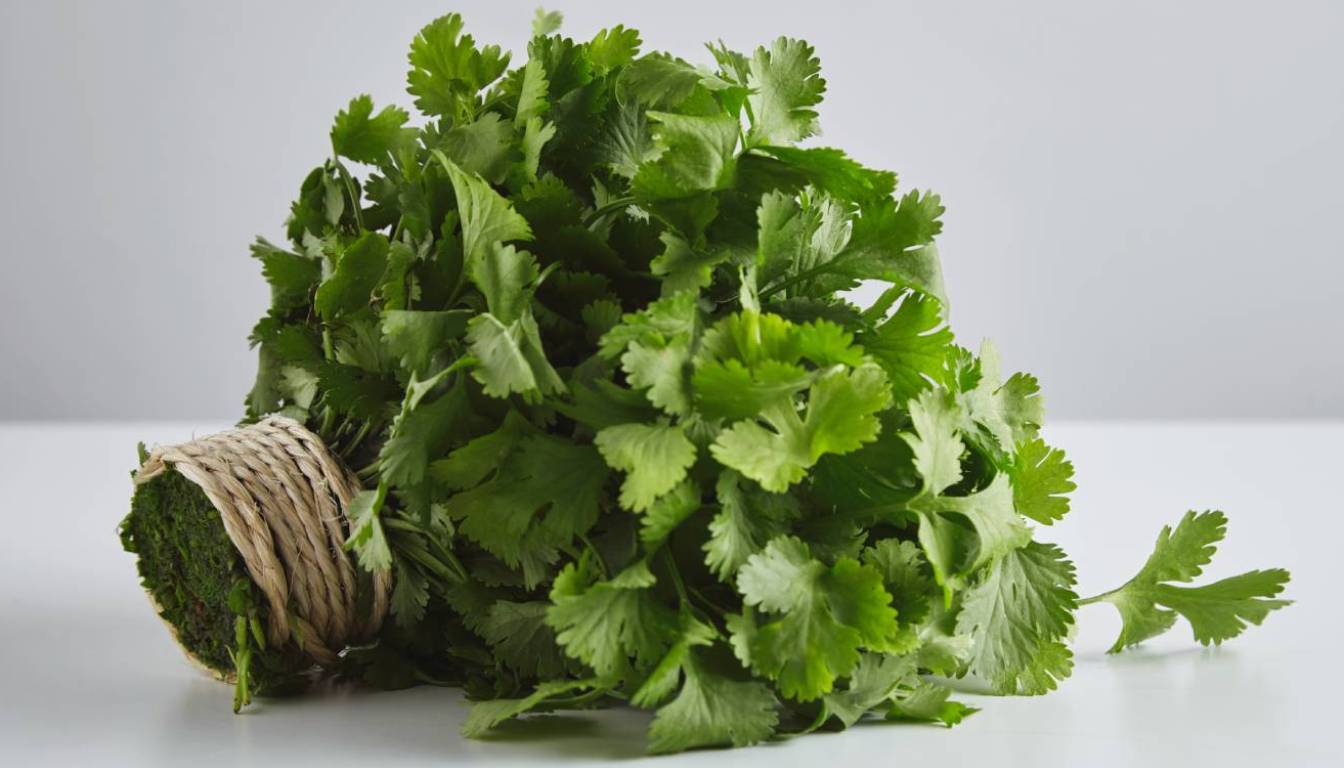Paul Johnston is the founder and master herbalist of The Herb Prof, with decades of clinical experience in naturopathic medicine, herbal remedies, detoxification and holistic wellness. After overcoming his own serious health challenges, he now dedicates himself to helping others reclaim their health naturally.
Cilantro is a widely used herb in global cuisines, known for its fresh, citrusy, and slightly peppery flavor and aroma. So, what is the taste of cilantro like? As someone who has tried it, I can say it possesses a distinctive taste that’s challenging to put into words.
Cilantro is often confused with coriander, the seed of the cilantro plant. While they come from the same plant, they have different flavors. Coriander has a warm, earthy, and slightly spicy taste, while cilantro has a fresher and more citrusy taste. It is important to note that not everyone enjoys the taste of cilantro, as some people find it soapy or unpleasant. According to a search result from Cleveland Clinic, this dislike for cilantro may be due to genetics and how our olfactory receptors perceive the smell.
What Is Cilantro and Its Flavor Profile
As a professional chef, I have worked with cilantro in many dishes. Cilantro is a popular herb that is widely used in many cuisines around the world. It is also known as coriander, which is the name of the plant that produces both the herb and the spice. Cilantro is derived from the leaves and stems of the coriander plant (Coriandrum sativum), while coriander is made from the dried seeds of the same plant.
Lemony Citrus
Cilantro has a unique flavor profile that can be difficult to describe. It has a fresh, citrusy, and slightly bitter flavor with a hint of sweetness. The citrusy flavor is often compared to lemon, and it is one of the reasons why cilantro is commonly used in Mexican and other Latin American cuisines. The flavor of cilantro comes from the essential oils that are found in the leaves and stems of the plant.
Peppery
In addition to its citrusy flavor, cilantro also has a slightly peppery taste. This is due to the presence of aldehydes, which are organic compounds that are responsible for the herb’s aroma and flavor. The peppery taste of cilantro is what makes it a great addition to spicy dishes, such as curries and salsas.
Overall, cilantro’s aroma is a critical component of its unique flavor profile, making it a popular herb in many cuisines. The Fresh cilantro leaves are often used as a garnish to add flavor and color to dishes. The aroma of cilantro is also an important factor in its use in cooking. The herb’s aroma is often described as fresh and slightly spicy, which makes it a great addition to soups, stews, and other savory dishes.
Why Does Cilantro Taste Like Soap to Some People?
Cilantro is a herb that is commonly used in various cuisines around the world. While some people love its distinct flavor, others find it unappetizing and even describe it as tasting like soap. In this section, I will explore the reasons why cilantro tastes like soap to some people.
Genetic Predisposition
According to a study published in the journal Flavour, people who dislike cilantro may have a genetic predisposition to do so. These individuals have a variation in a group of olfactory-receptor genes that allows them to strongly perceive the soapy-flavored aldehydes in cilantro leaves. This genetic quirk is usually only found in a small percentage of the population, though it varies geographically. For example, East Asians are more likely to have this genetic variation than people of European descent.
Supertasting Abilities
Another reason why cilantro tastes like soap to some people is that they may be supertasters. Supertasters are people who have a heightened sense of taste and are more sensitive to bitter and pungent flavors. About 25 percent of the population are thought to be supertasters. So obviously, while you can be both a supertaster and averse to cilantro, you can also just have the anti-cilantro thing, like my mom.
Cilantro can taste like soap to some people due to genetic predisposition or supertasting abilities. While it may not be everyone’s favorite herb, it is an essential ingredient in many dishes and is worth trying in different recipes to see if you can develop a taste for it.
Can You Learn to Like Cilantro?
As a herb, cilantro has a unique flavor that can be described as citrusy, slightly sweet, and pungent. However, some people find it unpleasant and describe it as soapy or metallic. If you are one of those people, you may wonder if it is possible to learn to like cilantro. Here are some ways to try.
Exposure Therapy
Exposure therapy involves gradually exposing yourself to the food you dislike until you develop a tolerance for it. To use this method, start by adding a small amount of cilantro to your meal and gradually increase the amount over time. You can also try adding it to different dishes to see if you like it better in a particular context.
Blending with Other Flavors
Blending cilantro with other flavors can help mask its taste and make it more palatable. For example, you can mix it with garlic, lime juice, and salt to make a flavorful salsa. You can also try blending it with other herbs like parsley to mellow out its flavor.
Finding Alternatives – What Does Cilantro Taste Like?
If you have tried exposure therapy and blending with other flavors and still can’t stand cilantro, you can try using a substitute. Chinese parsley, also known as coriander, has a similar flavor profile and can be used in place of cilantro in many recipes. You can also try using other herbs like basil or mint as a garnish instead.
Whether you love it or hate it, cilantro is a versatile herb that can add flavor and depth to your cooking. If you are one of those people who can’t stand its taste, try exposure therapy, blending with other flavors, or finding alternatives to see if you can learn to like it.
Before You Go – What Does Cilantro Taste Like?

Cilantro is a unique herb that has a complex flavor profile that can be difficult to describe. Some people find it to be bright and citrusy, while others find it to be earthy and slightly spicy. The taste of cilantro can vary from person to person due to genetic differences in taste perception.
Coriander, on the other hand, has a warm, earthy, and spicy flavor and can be compared to cumin. It is often paired with cilantro in recipes, as well as with cinnamon.
Apart from its culinary uses, cilantro has some potential health benefits. It is high in antioxidants and may help reduce inflammation. It may also have antimicrobial properties and help improve digestive health.
Overall, cilantro is a versatile herb that can be used in a variety of dishes, from Mexican cuisine to Asian stir-fries. Whether you love it or hate it, there’s no denying that cilantro adds a unique flavor to any dish.
What Does Cilantro Taste Like
Hello, herb enthusiasts! Today, we’re embarking on a flavor journey with cilantro. It’s like a taste test, but with herbs!
Now, how does this topic and theherbprof.com connect? Well, let me tell you. The website is a gold mine of information about herbs and their flavors. So, if you’re looking to learn about the taste of cilantro, theherbprof.com is your go-to place.
This blog post, on the other hand, serves as a launchpad to that wealth of information. Think of it as your friendly neighbourhood guide, pointing you towards the right herbs and the right flavors. And the best part? It’s all about sharing knowledge and promoting a healthier lifestyle through herbs.
References – What Does Cilantro Taste Like?
Little Herb Encyclopedia, by Jack Ritchason; N.D., Woodland Publishing Incorporated, 1995
The Ultimate Healing System, Course Manual, Copyright 1985, Don Lepore
Planetary Herbology, Michael Tierra, C.A., N.D., Lotus Press, 1988
Handbook of Medicinal Herbs, by James A. Duke, Pub. CRP Second Edition 2007
The Complete Medicinal Herbal, by Penelope Ody, Published by Dorling Kindersley
Check the Following Articles!
Growing Herbs in Kitchen: A Fresh and Flavorful Cooking
Herb Gardening For Beginners: Tricks for a Successful Start
Growing Basil Indoors During Winter: How To Do It!
Frequently Asked Questions – What Does Cilantro Taste Like?
What causes the soapy taste associated with cilantro for some people?
The soapy taste associated with cilantro for some people is caused by a genetic variation in olfactory-receptor genes. According to Mashed, this genetic variation makes some people perceive the aldehydes in cilantro as soapy or metallic.
Is the sensitivity to cilantro’s flavor a dominant or recessive trait?
The sensitivity to cilantro’s flavor is a dominant trait. This means that if one parent has the gene, there is a 50% chance that their child will also inherit the gene and be sensitive to cilantro’s flavor. However, there are cases where both parents are not sensitive to cilantro’s flavor, but their child is. This is because the gene can skip a generation or be passed down from a distant ancestor. Fanatically Food explains that the sensitivity to cilantro’s flavor is not related to ethnicity.
What percentage of the population reports a soap-like taste when eating cilantro?
According to Live Eat Learn, about 14% of the population reports a soap-like taste when eating cilantro. However, this number can vary depending on the study and the population being studied. It is important to note that sensitivity to cilantro’s flavor is not a food allergy, and it is not harmful to consume cilantro.
What are the alternatives to cilantro for those who dislike its flavor?
For those who dislike the flavor of cilantro, several alternatives can be used in recipes. Some of these alternatives include parsley, basil, mint, and dill. These herbs have a similar flavor profile to cilantro, but without the soapy taste that some people dislike. Mashed recommends experimenting with different herbs to find the one that works best for your recipe.
How can one neutralize the soapy flavor of cilantro in dishes?
One way to neutralize the soapy flavor of cilantro in dishes is to use the leaves and stems separately. According to The Spruce Eats, the stems of cilantro contain more aldehydes than the leaves, which can contribute to the soapy taste. By using only the leaves and chopping them finely, the soapy taste can be minimized. Another way to neutralize the soapy flavor of cilantro is to cook it. Cooking cilantro can help to break down the aldehydes and reduce the soapy taste.
What are the health benefits of including cilantro in one’s diet?
Cilantro is a nutrient-dense herb that is low in calories and high in vitamins and minerals. According to DIY Herb Gardener, cilantro is a good source of vitamin C, vitamin K, and potassium. It also contains antioxidants and has anti-inflammatory properties. Cilantro has been shown to have a positive effect on digestion and can help to reduce bloating and gas.

